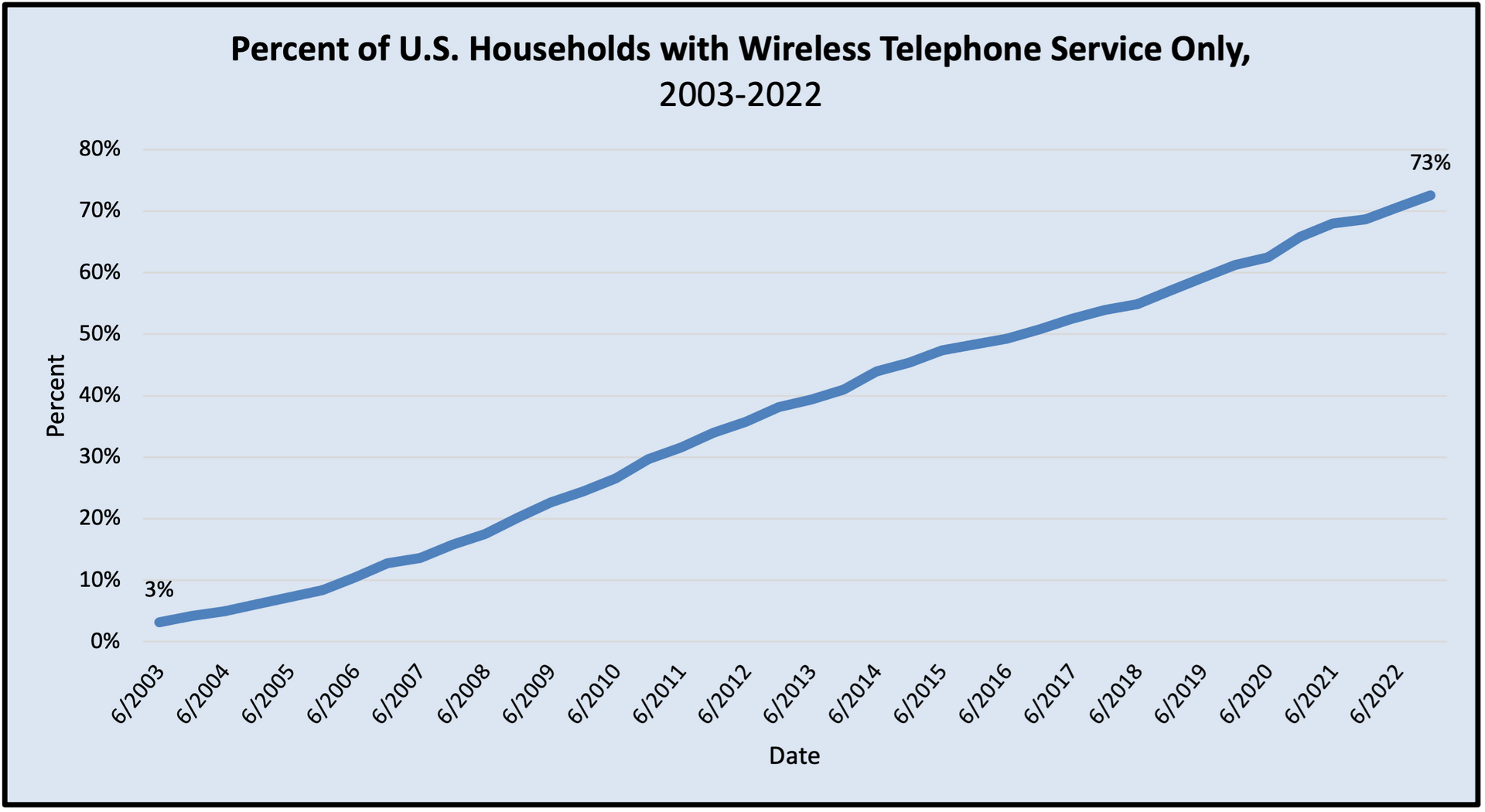The Decline of Landlines and the Rise of Political Polling

What kind of telephone do you use?
Do you have a landline? Do you rely only on a mobile (wireless) phone? Do you have both? Or do you not have any kind of telephone service at all?
The National Health Interview Survey has been tracking these statistics for 20 years. Unfortunately, they are not available on a county basis, so we can’t look at the Eastern Shore, but they’re interesting, nonetheless.
The NHIS is a federal government program that conducts interviews about health issues. They interview Americans by telephone and started asking respondents about their choice of telephone device when cell phones started to be a bigger presence in Americans’ means of communications. Twice a year, the agency releases a report with estimates of what they call “Wireless Substitution.”
Nationally, as of the end of 2022, two-thirds of American adults were “wireless-only” — they had their own wireless phone and lived in a household that did not have a landline. Here are the characteristics of the wireless-only adult Americans:
- The percent of wireless-only adults decreased by age: 85% of adults 25-34 relied only on a wireless phone, whereas 40% of those over 65 did.
- Hispanic adults (80%) were more likely than non-Hispanic Asian (73%), non-Hispanic Black (70%), or non-Hispanic White (70%) adults to be wireless-only.
- Men (72%) were slightly more likely than women (71%) to be wireless-only.
- Adults living in the West (76%), Midwest (74%), and South (74%) were more likely than those living in the Northeast (58%) to be wireless-only (Maryland is included in the South).
- The percent of wireless-only adults decreased with an increase in family income: 78% of poor adults and 75% of near-poor adults were wireless-only, compared with 71% of adults with higher family incomes.
- Adults living in rented homes were more likely to be wireless-only (85%) than adults living in homes owned by a household member (66%).
Quite the opposite are the adults who live in a landline-only household, which, at the end of 2022, was a smidge over 1%. Adults over 65 account for most of this group.
And there are those who, even though they own wireless phones, hold on to their landlines; at the end of 2022, these folks accounted for a quarter of adults. Adults over 65 account for most of this group as well.
Households without phone service at all has remained steady at less than 1% for a number of years.

Pollsters, researchers, and others who once relied on telephone communications to gauge the opinions of Americans saw the trend toward wireless telephone use and quickly changed the way they did business.
Using a sample pulled from the universe of landline telephone numbers was once an acceptable way to get a representative sample of Americans because most everyone had a landline.
But as wireless phones became more prevalent, the universe of landlines became increasingly less representative (see the statistics above to illustrate the uneven adoption of wireless technology among demographic groups). So wireless telephones were added to the universe.
However, wireless phone owners proved just as reluctant as landline owners to answer calls from unknown callers. So many survey operations moved online.
For online polling, representative samples are generally selected from an address file, not a telephone file. Respondents are contacted via mail, with an invitation to participate in a survey, and are then instructed on how to participate online; if the individual does not have online access, it can be provided.
But an opportunity presented itself with online polling that had not existed before: opt-in surveys. The people who participate in these surveys sign themselves up to get money or other rewards by taking surveys or they are recruited by a company. For example, after responding to a survey designed on the Survey Monkey platform, people are offered the opportunity to take another survey; certain credit card companies extend offers of rewards for survey participation.
Pew Research Center estimates that “more than 80% of the public polls used to track key indicators of U.S. public opinion, such as the president’s approval rating or support for Democratic presidential candidates, are conducted using online opt-in polling.” Hmmm. That sounds like a lot.
To try to gauge what effect this survey method has on results, Pew Research Center did a study. Published in 2020, the study surveyed over 62,000 U.S. adults using different online methods of surveying. Responses were then examined for quality.
The study found that online surveys can be influenced by “bogus respondents.” A bogus respondent is defined as a person who took the survey multiple times; or lived outside the United States (even though the survey asked for U.S. adults to respond); or gave multiple illogical or plagiarized open-ended answers; or always said they approve or favor regardless of what was asked.
The study found that the opt-in survey where respondents were paid or otherwise rewarded for their participation had a relatively large number of bogus respondents — 7%. The surveys where the respondents were recruited by survey companies had fewer (4-6%). These numbers are large enough to affect the outcome of a poll. The surveys that used a representative sample of respondents randomly sampled using addresses had too few bogus respondents (1%) to have any significant effect.
Fraudulent data generated by bots is also a problem — an “emergent threat to many opt-in polls,” according to the Pew Research Center. At least one commercial bot product is currently available to participate in surveys and polls.
The Pew Research Center is careful to state that, although their findings indicate problems with some online polling, polling is not broken. But there are problems with some methods of online surveying that will only get worse.
We’ve been warned by many sources not to put any stock in the 2024 presidential polls this early in the game. That sounds like good advice. Plus, we should also pay more attention to the way polling data are collected if we want to have confidence in the results.
Jan Plotczyk spent 25 years as a survey and education statistician with the federal government, at the Census Bureau and the National Center for Education Statistics. She retired to Rock Hall.
Common Sense for the Eastern Shore







